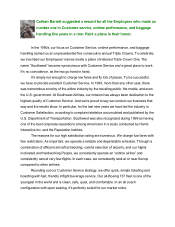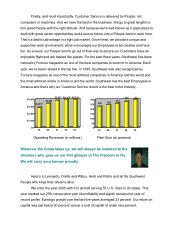Southwest Airlines 1999 Annual Report Download - page 20
Download and view the complete annual report
Please find page 20 of the 1999 Southwest Airlines annual report below. You can navigate through the pages in the report by either clicking on the pages listed below, or by using the keyword search tool below to find specific information within the annual report.results. Such uncertainties include, but may not be limited to, changes in passenger revenue levels and/or
consumer ticket purchasing habits.)
Aircraft rentals per ASM decreased 11.6 percent in 1999 compared to 1998, primarily due to
a lower percentage of the aircraft fleet being leased. Approximately 30.8 percent of the Company’ s
aircraft fleet were under operating lease at December 31, 1999, compared to 35.4 percent at
December 31, 1998.
Depreciation expense per ASM was flat for 1999 compared to 1998. Although the Company
owned a higher percentage of its aircraft fleet in 1999 versus 1998, unit cost was flat due to a change in
the estimated useful lives of the Company’ s Boeing 737-300/-500 aircraft from 20 years to 23 years.
See Note 2 to the Consolidated Financial Statements. This change in accounting estimate was made
January 1, 1999, and resulted in a decrease in depreciation expense of approximately $25.7 million for
1999. As the Company’ s fleet ownership percentage continues to increase in 2000 compared to 1999,
the Company anticipates an increase in depreciation expense per ASM. (The immediately preceding
sentence is a forward-looking statement involving uncertainties that could result in actual results differing
materially from expected results. Such uncertainties include, but may not be limited to, a change in the
Company’ s aircraft financing strategy.)
Other operating expenses per ASM increased 0.7 percent in 1999 compared to 1998. This
increase was primarily due to increased credit card processing costs resulting from a higher percentage
of the Company’ s ticket sales purchased with credit cards.
OTHER “O ther expenses (income)” included interest expense, capitalized interest, interest
income, and other gains and losses. Interest expense decreased 3.8 percent in 1999 primarily due to the
February 1998 redemption of $100 million of senior unsecured 9 1/4% Notes originally issued in
February 1991. Capitalized interest increased 22.2 percent in 1999 as a result of higher 1999 progress
payment balances for scheduled future aircraft deliveries. Interest income for 1999 decreased 18.9
percent primarily due to lower invested cash balances. Other losses in 1999 resulted primarily from a
write-down associated with the consolidation of certain software development projects. Other gains in
1998 primarily consisted of contractual penalties received from Boeing due to delays in the delivery of
737-700 aircraft.
INCOME TAXES The provision for income taxes, as a percentage of income before taxes,
increased slightly to 38.68 percent in 1999 from 38.53 percent in 1998.
























